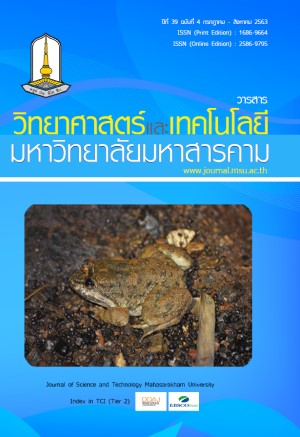Factors affecting Musculoskeletal Disorders from the work of the silk weaving professions in Chaiyaphum province
Main Article Content
Abstract
Musculoskeletal disorders from the work of the silk weaving professions became important problems affecting the production effectiveness. This study aims at exploring the prevalence rate and factors affecting the musculoskeletal disorders of 150 members of silk weaving professions in Chaiyaphum province. The data collection was made by using questionnaire applied from the Standardized Nordic questionnaire and the musculoskeletal disorders evaluation form developed by The Department of Disease Control. The data was analyzed in statistic descriptive and binary logistic regression. The results revealed that the members of the silk weaving professions had problems of their muscle aches the most on their feet, ankles, bottoms and hips at the rate of 100%. The below back pain and knee pain were informed at 98% and 96.67% respectively. Factors affecting the musculoskeletal disorders found were 1) the body mass index, 2) the exertion to press or squeeze objects during weaving, 3) the exertion to twist their bodies back and forth during weaving, 4) the length of weaving time per day, 5) the continuous bending down of their heads to work, and 6) the age of workers.
Article Details
References
2. Porter ME. The competitive advantage of nations (London and Basingstoke). 1990.
3. Youprasert, A. (2009). Factors affecting decision
of patients with myopathy to choose Thai traditional
massage services at public health care unit Lamphun municipality. Chiang Mai University: Chiang Mai.
4. Irjayanti M, Azis AM. Barrier factors and potential solutions for Indonesian SMEs. Procedia Economics and Finance. 2012 Jan 1;4:3-12.
5. มาโนช ริทินโย. ปัจจัยที่ส่งผลต่อประสิทธิภาพการผลิตของวิสาหกิจชุมชนผ้าไหมทอมือจังหวัดนครราชสีมา. วารสารวิศวกรรมศาสตร์ มหาวิทยาลัยเชียงใหม่ 2560 เม.ย. 27; 24(1):180-193.
6. มาโนช ริทินโย, นิคม ลนขุนทด, อรุณ อุ่นไธสง, วิทยา อินทร์สอน. การพัฒนาเครื่องค้นหูกเส้นไหมด้วยเทคนิคECRS. วารสารวิชาการวิศวกรรมศาสตร์ มหาวิทยาลัยอุบลราชธานี. 2560;10(2):52-61.
7. Chang, J. H., Wu, J. D., Liu, C. Y., & Hsu, D. J.
(2012). Prevalence of musculoskeletal disorders and ergonomic assessments of cleaner. American Journal of Industrial Medicine, 55(7), 593-604.
8. Garcia PP, Pinelli C, dos Reis Derceli J, Campos JÁ. Musculoskeletal disorders in upper limbs in dental students: exposure level to risk factors. Brazilian Journal of Oral Sciences. 2012;11(2): 148-153.
9. Bureau of Labor Statistics. (2013). Nonfatal
occupational injuries and illnesses requiring daysaway formwork. Retrieved from http://www. bls.gov/iif/home.htm
10. Choobineh A, Hosseini M, Lahmi M, Jazani RK, Shahnavaz H. Musculoskeletal problems in Iranian hand-woven carpet industry: Guidelines for workstation design. Applied ergonomics. 2007 Sep 1;38(5):617-624.
11. Banerjee P, Gangopadhyay S. A study on the prevalence of upper extremity repetitive strain injuries among the handloom weavers of West Bengal. Journal of human ergology. 2003 Jun 15;32(1):17-22.
12. Nag A, Vyas H, Nag PK. Gender differences, work stressors and musculoskeletal disorders in weaving industries. Industrial health. 2010;48(3): 339-48.
13. Kroemer KH. Cumulative trauma disorders: their recognition and ergonomics measures to avoid them. Applied ergonomics. 1989 Dec 1;20(4):274-280.
14. น้ำเงิน จันทรมณี, สสิธร เทพตระการพร, ผกามาศ พิริยะ ประสาธน์. ปัญหาการปวดเมื่อยกล้ามเนื้อจาก การทำงานของกลุ่มอาชีพการทอผ้าด้วยมือในเขตภาค เหนือตอนบนของประเทศไทย. วารสารความ ปลอดภัยและสุขภาพ. 2557 เม.ย. 28;7(24):29-40.
15. I. Kuorinka BJt, A. Kilbom, H. Vinterberg t t , F. Biering-S6rensen , G. Andersson , et al,. Standardised Nordic questionnaires for the analysis of musculoskeletal symptoms. Applied Ergonomics. 1987;18 (3):233-7
16. Chuppawa W, Aungudornpukdee P. Prevalence and Factors affecting Musculoskeletal Disorders among Cleaners.Naresuan University Journal: Science and Technology (NUJST). 2017 Feb 10;25(1):23-31.
17. van den Berg, T. I. J., Elders, L. A. M., de Zwart, B. C. H.andBurdorf, A. (2009). The effects of work-related and individual factors on the Work Ability Index: a systematic review. Occupational and Environmental Medicine, 66(4), 211-220. doi: 10.1136/oem.2008.039883
18. Bergman, S., Herrstrom, P., Hogstrom, K., Petersson, I. F., Svensson, B., & Jacobsson, L. T. (2001). Chronic musculoskeletal pain, prevalence rates, and sociodemographic associations in a Swedish population study. J Rheumatol, 28(6), 1369-1377.
19. Bernard BP. Musculoskeletal disorder and workplace factor: Critical review of epidemiology evidence for work-related musculoskeletal disorder of the neck, upper extremity and low back. 1997 [cited 2013 Sep 14]. Available from: http://www.cdc.gov/niosh/ 97-141pd.html.
20. Wendy, H. 2008. “The effect of body mechanics education on the work performance of fruit warehouse workers”. Work. 31(4): 461-471.
21. Massaccesi M, Pagnotta A, Soccetti A, Masali M, Masiero C, Greco F. Investigation of work-related disorders in truck drivers using RULA method. Applied ergonomics. 2003 Jul 1;34(4):303-7.
22. Promsri A. Posture and work-related injury in Ban Ngiew’s stone mortar workers, Phayao Province. Srinagarind Medical Journal. 2015;30(5):467-73.
23. นันทพร เมฆสวัสดิชัย, ตรีอมร วิสุทธิศิริ, ณัฐวุฒิ แดง สวัสดิ์. การประเมินความเสี่ยงต่อสุขภาพและ พฤติกรรมการป้องกันอันตรายในการทำงานของกลุ่ม แรงงานนอกระบบในจังหวัดพระนครศรีอยุธยา. วารสารควบคุมโรค. 2554 ก.ย. 30;37(3):151-9.
24. Silva C, Barros C, Cunha L, Carnide F, Santos M. Prevalence of back pain problems in relation to occupational group. International Journal of Industrial Ergonomics. 2016 Mar 1;52-8.
25. Maakip I, Keegel T, Oakman J. Prevalence and predictors for musculoskeletal discomfort in Malaysian office workers: Investigating explanatory factors for a developing country. Applied ergonomics. 2016 Mar 1;53:252-7.
26. สุนิสา ชายเกลียง, ธัญญาวัฒน์ หอมสมบัติ. การประเมินความเสียงทางการยศาสตร์การทํางาน โดยมาตรฐาน LULAในกลุ่มแรงงานทําไม้กวาดร่มสุข. ศรีนคริทร์เวชสาร. 2554; 26 (1): 35-40.
27. Sagar Waghambare Sunil Londhe Rupesh Rakibe Yashwant Nalawade Sneha Bire and Sachin Dixit. (2016). “Review on design and automation of axle assembly by using jig and fixture on conveyor process line”: International Conference on Emerging Trends in Engineering and Management Research, Anjaneri. pp. 95-104. Nashik.
28. Brun E. The occupational safety and health of cleaning workers EU-OSHA. Luxembourg: Office for Official Publications of the European Communities: European Agency for Safety and Health at Work. 2009.


